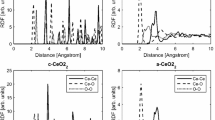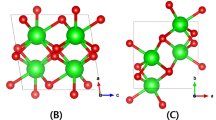Abstract
Resistance change random access memories based on transition metal oxides had been recently proposed as promising candidates for the next generation of memory devices, due to their simplicity in composition and scaling capability. The resistance change phenomena had been observed in various materials, however the fundamental understanding of the switching mechanism and of its physical origin has not been agreed upon. We have employed first principles simulations based on density functional theory to elucidate the effect of oxygen vacancies on the electronic structure of rutile TiO2 and NiO using the local density and generalized gradient approximations with correction of on-site Coulomb interactions (LDA + U for TiO2 and GGA + U for NiO). We find that an ordered oxygen vacancy filament induces several defect states within the band gap of both materials, and can lead to the defect-assisted electron transport. This state may account for the “ON”-state low resistance conduction observed experimentally in rutile TiO2 and NiO. As the filament structure is perturbed by oxygen ions moving into the ordered chain of vacancies under applied electric field, charges are trapped and the conductivity can be significantly reduced. We predict this partially disordered arrangement of vacancies may correspond to the “OFF”-state of the resistance change memories.




























Similar content being viewed by others
References
Chen A, Haddad S, Wu YC, Lan Z, Fang TN, Kaza S (2007) Appl Phys Lett 91:123517-1-3
Kim DC, Seo S, Ahn SE, Suh DS, Lee MJ, Park BH, Yoo IK, Baek IG, Kim HJ, Yim EK, Lee JE, Park SO, Kim HS, Chung UI, Moon JT, Ryu BI (2006) Appl Phys Lett 88:202102-1-3
Fujii T, Kawasaki M, Sawa A, Akoh H, Kawazoe Y, Tokura Y (2004) Appl Phys Lett 86:012107-1-3
Guo X, Schindler C, Menzel S, Waser R (2007) Appl Phys Lett 91:133513-1-3
Waser R, Dittmann R, Staikov G, Szot K (2009) Adv Mater 21:2632
Strachan JP, Strukov DB, Borghetti J, Yang JJ, Medeiros-Ribeiro G, Williams RS (2011) Nanotechnology 22:254015-1-6
Kim KM, Jeong DS, Hwang CS (2011) Nanotechnology 22:254002-1-7
Szot K, Rogala M, Speier W, Klusek Z, Besmehn A, Waser R (2011) Nanotechnology 22:254001-1-21
Ielmini D, Nardi F, Cagli C (2011) Nanotechnology 22:254022-1-12
Waser R, Aono M (2007) Nat Mater 6:833
Szot K, Speier W, Carius R, Zastrow U, Beyer W (2002) Phys Rev Lett 88:075508-1-4
Janousch M, Meijer GI, Staub U, Delley B, Karg SF, Andreasson BP (2007) Adv Mater 19:2232
Poumellec B, Durham PJ, Guo GY (1991) J Phys Condens Mater 3:8195
Park SG, Magyari-Köpe B, Nishi Y (2010) Phys Rev B 82:115109-1-9
Park SG, Magyari-Köpe B, Nishi Y (2011) IEEE Electron Device Lett 32:197
Yang JJ, Miao F, Pickett MD, Ohlberg DAA, Stewart DR, Lau CN, Williams RS (2009) Nanotechnology 20:215201-1-9
Kwon DH, Kim KM, Jang JH, Jeon JM, Lee MH, Kim GH, Li XS, Park GS, Lee B, Han S, Kim M, Hwang CS (2010) Nat Nanotechnol 5:148
Magyari-Köpe B, Tendulkar M, Park SG, Lee HD, Nishi Y (2011) Nanotechnology 22:254029-1-11
Park SG, Magyari-Köpe B, Nishi Y (2011) Theoretical study of the resistance switching mechanism in rutile TiO2−x for ReRAM: the role of oxygen vacancies and hydrogen impurities. In: Techn. Digest of VLSI Symposium, p 46
Kamiya K, Yang MY, Park SG, Magyari-Köpe B, Nishi Y, Niwa M, Shiraishi K (2012) Appl Phys Lett 100:073502-1-4
Jameson JR, Fukuzumi Y, Wang Z, Griffin P, Tsunoda K, Meijer GI, Nishi Y (2007) Appl Phys Lett 91:112101-1-3
Dong R, Lee DS, Pyun MB, Hasan M, Choi HJ, Jo MS, Seong DJ, Chang M, Heo SH, Lee JM, Park HK, Hwang H (2008) Appl Phys A Mater Sci Process 93:409
Jeong HY, Lee JY, Choi SY (2010) Adv Funct Mater 20:3912
Choi BJ, Jeong DS, Kim SK, Rohde C, Choi S, Oh JH, Kim HJ, Hwang CS, Szot K, Waser R, Reichenberg B, Tiedke S (2005) J Appl Phys 98:033715-1-10
Lee MJ, Han S, Jeon SH, Park BH, Kang BS, Ahn SE, Kim KH, Lee CB, Kim CJ, Yoo IK, Seo DH, Li XS, Park JB, Lee JH, Park Y (2009) Nano Lett 9:1476
Simmons JG, Verderbe R (1967) Proc Royal Soc Lond A Math Phys Sci 301:77
Tang H, Li F, Shinar J (1997) Appl Phys Lett 71:2560
Sato Y, Kinoshita K, Aoki M, Sugiyama Y (2007) Appl Phys Lett 90:033503-1-3
Park C, Jeon SH, Chae SC, Han S, Park BH, Seo S, Kim DW (2008) Appl Phys Lett 93:042102-1-3
Lee CB, Kang BS, Benayad A, Lee MJ, Ahn SE, Kim KH, Stefanovich G, Park Y, Yoo IK (2008) Appl Phys Lett 93:042115-1-3
Lee SR, Kim HM, Bak JH, Park YD, Char K, Park HW, Kwon DH, Kim M, Kim DC, Seo S, Li XS, Park GS, Jung R (2010) Jpn J Appl Phys 49:031102
Lee HD, Magyari-Köpe B, Nishi Y (2010) Phys Rev B 81:193202-1-4
Sinnott SB, Wood RF, Pennycook SJ (2000) Phys Rev B 61:15645
Glassford KM, Chelikowsky JR (1992) Phys Rev B 46:1284
Lee C, Ghosez P, Gonze X (1994) Phys Rev B 50:13379
Dudarev SL, Botton GA, Savrasov SY, Humphreys CJ, Sutton AP (1998) Phys Rev B 57:1505
Liechtenstein AI, Anisimov VI, Zaanen J (1995) Phys Rev B 52:R5467
Heyd J, Scuseria GE, Ernzerhof M (2003) J Chem Phys 118:8207
Faleev SV, van Schilfgaarde M, Kotani T (2004) Phys Rev Lett 93:126406-1-4
Kresse G, Furthmüller J (1996) Phys Rev B 54:11169
Kresse G, Furthmüller J (1996) Comput Mater Sci 6:15
Blöchl PE (1994) Phys Rev B 50:17953
Kresse G, Joubert D (1999) Phys Rev B 59:1758
Earle MD (1942) Phys Rev 61:56
Cronemeyer DC (1959) Phys Rev 113:1222
Chen J, Lin LB, Jing FQ (2001) J Phys Chem Solids 62:1257
Cho E, Han S, Ahn HS, Lee KR, Kim SK, Hwang CS (2006) Phys Rev B 73:193202-1-4
Ramamoorthy M, Kingsmith RD, Vanderbilt D (1994) Phys Rev B 49:7709
Janotti A, Varley JB, Rinke P, Umezawa N, Kresse G, Van de Walle CG (2010) Phys Rev B 81:085212-1-7
Calzado CJ, Hernandez NC, Sanz JF (2008) Phys Rev B 77:045118-1-10
Deskins NA, Dupuis M (2007) Phys Rev B 75:195212-1-10
Janotti A, Segev D, Van de Walle CG (2006) Phys Rev B 74:045202-1-9
Silvi B, Savin A (1994) Nature 371:683
Szot K, Speier W, Bihlmayer G, Waser R (2006) Nat Mater 5:312
Park S, Ahn HS, Lee CK, Kim H, Jin H, Lee HS, Seo S, Yu J, Han S (2008) Phys Rev B 77:134103-1-7
Bosman AJ, Vandaal HJ, Knuvers GF (1965) Phys Lett 19:372
Jung K, Seo H, Kim Y, Im H, Hong J, Park JW, Lee JK (2007) Appl Phys Lett 90:052104-1-3
Acknowledgements
The Stanford Non-Volatile Memory Technology Research Initiative (NMTRI), and the Marco Focus Center (MSD) sponsored this study. The computational study was carried out using the National Nanotechnology Infrastructure Network’s Computational Cluster at Stanford.
Author information
Authors and Affiliations
Corresponding author
Rights and permissions
About this article
Cite this article
Magyari-Köpe, B., Park, S.G., Lee, HD. et al. First principles calculations of oxygen vacancy-ordering effects in resistance change memory materials incorporating binary transition metal oxides. J Mater Sci 47, 7498–7514 (2012). https://doi.org/10.1007/s10853-012-6638-1
Received:
Accepted:
Published:
Issue Date:
DOI: https://doi.org/10.1007/s10853-012-6638-1




